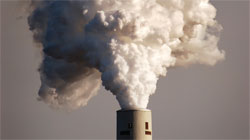A recent study conducted by NERA Economic Consulting — funded in part by fossil fuel industry trade groups — falsely inflates the cost of the Environmental Protection Agency’s Clean Power Plan by denying energy efficiency’s proven ability to save consumers money. Here’s what they got wrong, and why it matters.

The Environmental Protection Agency’s proposal for limiting carbon emissions from existing power plants is under attack by fossil fuel special interests using flawed and biased analysis to artificially inflate cost estimates.
The NERA report purports to analyze the EPA’s historic proposal to limit heat-trapping carbon emissions from existing power plants. Power plants are the nation’s largest source of carbon emissions, and the EPA seeks to reduce these emissions by about 30 percent compared to 2005 levels by 2030.
In attempting to analyze the potential costs and benefits of the EPA’s proposal, NERA’s analysis suffers from a variety of errors and biases, particularly around the role that energy efficiency has to play in cost-effectively reducing carbon emissions.
Energy efficiency makes economic sense
Energy efficiency is a big part of the proposed pathway towards complying with the EPA’s new standard — and rightfully so. Study after study has shown energy efficiency has enormous potential to help meet electricity demand in the residential, commercial, and industrial sectors at costs lower than the cost of electricity. Two recent reviews, for example, show clearly how energy efficiency is America’s cheapest energy resource:
- A 2014 study by Lawrence Berkeley National Laboratory gathered data from energy efficiency programs in 30 states for 2009-2011 and found the average levelized cost to ratepayers is slightly more than 2 cents per kilowatt-hour.
- The American Council for an Energy-Efficient Economy (ACEEE) recently looked at the numbers for 20 states from 2009-2012 and arrived at a similar number: 2.8 cents per kilowatt-hour.
This post is part of a series on the EPA Clean Power Plan.
These studies indicate that even the EPA’s estimate of the cost to ratepayers of energy efficiency — about 3.25 cents per kilowatt-hour – may be too conservative.
The NERA study, though, makes no mention of any of these cost analyses, instead using a 2012 study that has been repeatedly discredited to justify assuming a levelized cost to electricity ratepayers of 5.3 cents per kilowatt-hour of energy saved. ACEEE actually wrote a white paper detailing the errors in the study that NERA cites, causing the study authors to make changes to the original study.

Energy efficiency is a cost-effective resource for meeting future energy demand. NERA’s use of a discredited 2012 study to estimate efficiency costs reveals a clear bias against energy efficiency. Photo: Shutterstock.com/Kzenon
Unfortunately, these changes were ultimately found (again by ACEEE) to be inadequate to fix the biases and flaws contained in the study. ACEEE ultimately concluded that the study authors “interpret available data in ways that best support their points, downplaying other research findings.” By ignoring readily available data from a wide array of credible sources in favor of such dubious assumptions, NERA reveals a clear bias against energy efficiency.
In fact, real world data shows that savings from energy efficiency outweigh the costs. A 2014 World Resource Institute review found that energy efficiency programs in 24 states “regularly save consumers $2 for every $1 invested, and in some cases up to $5.” Similarly, a study completed by ACEEE found that every dollar invested in energy efficiency yields $1.25-$4.00 in savings. Finally, in its own analysis, the EPA found that over the lifetime of the Clean Power Plan, consumers’ electricity bills will be 8 percent lower thanks to improvements in energy efficiency.
Why does NERA get it so wrong on efficiency?
NERA’s analysis was commissioned by fossil fuel industry trade groups that represent several of the world’s largest emitters of carbon emissions. Members of the American Coalition for Clean Coal Electricity include powerful coal interests, such as Peabody Energy and Murray Energy, whose CEO has described climate change as a “hoax” on Fox News. The Board of Directors for the American Fuel & Petrochemical Manufacturers (AFPM) includes BP, Chevron, ExxonMobil, and Shell.
While all of these big oil companies now publicly say they accept the science on climate change, AFPM has suggested that the EPA is obliged to consider claims “rejecting the existence and causes of climate change.” The EPA went above and beyond the call of duty and did just that, concluding that the scientific evidence supporting its finding that climate change threatens public health and the environment is “robust, voluminous, and compelling.”
It should come as no surprise that fossil fuel interests who spread disinformation on climate science are just as willing to mislead on the economics of climate solutions. The widely recognized need to address the growing threat of climate change should facilitate an honest discussion on the best ways to reduce our carbon emissions — one based on sound science and robust analysis.
Unfortunately, NERA’s biased and misleading study does nothing to further that effort.

